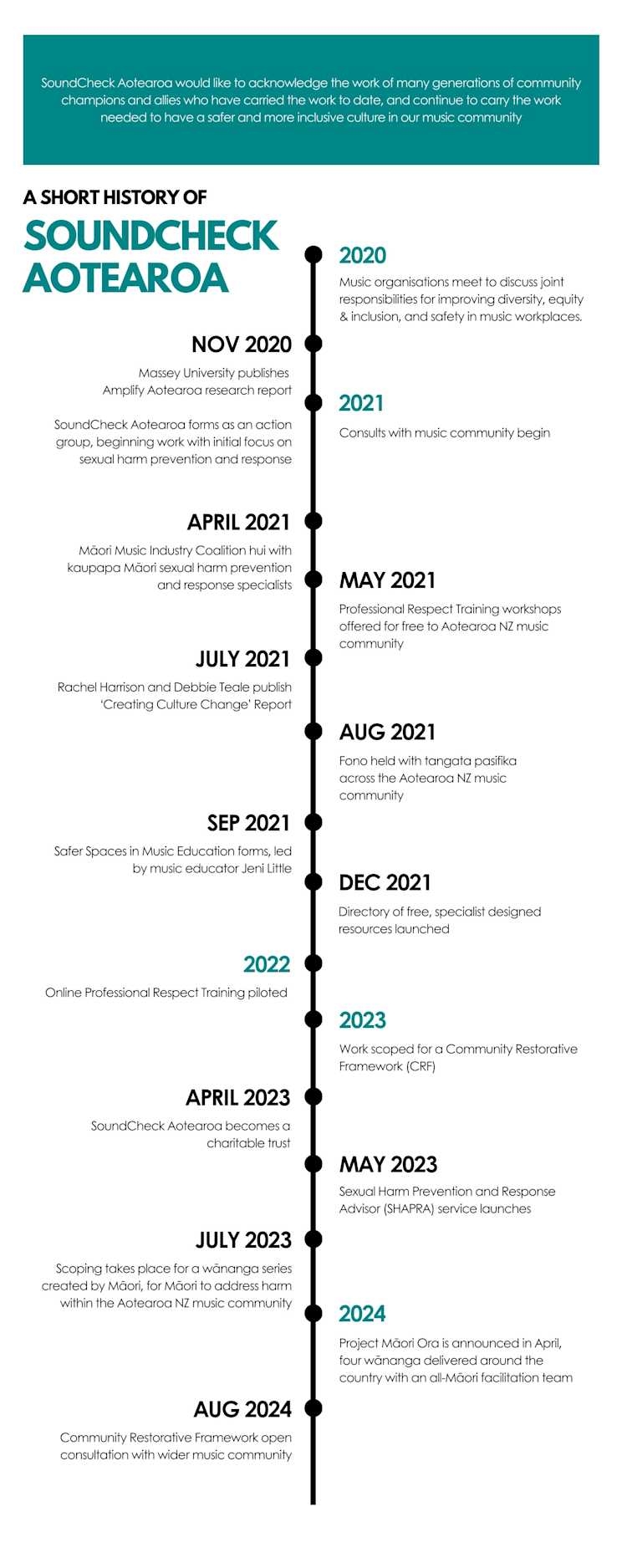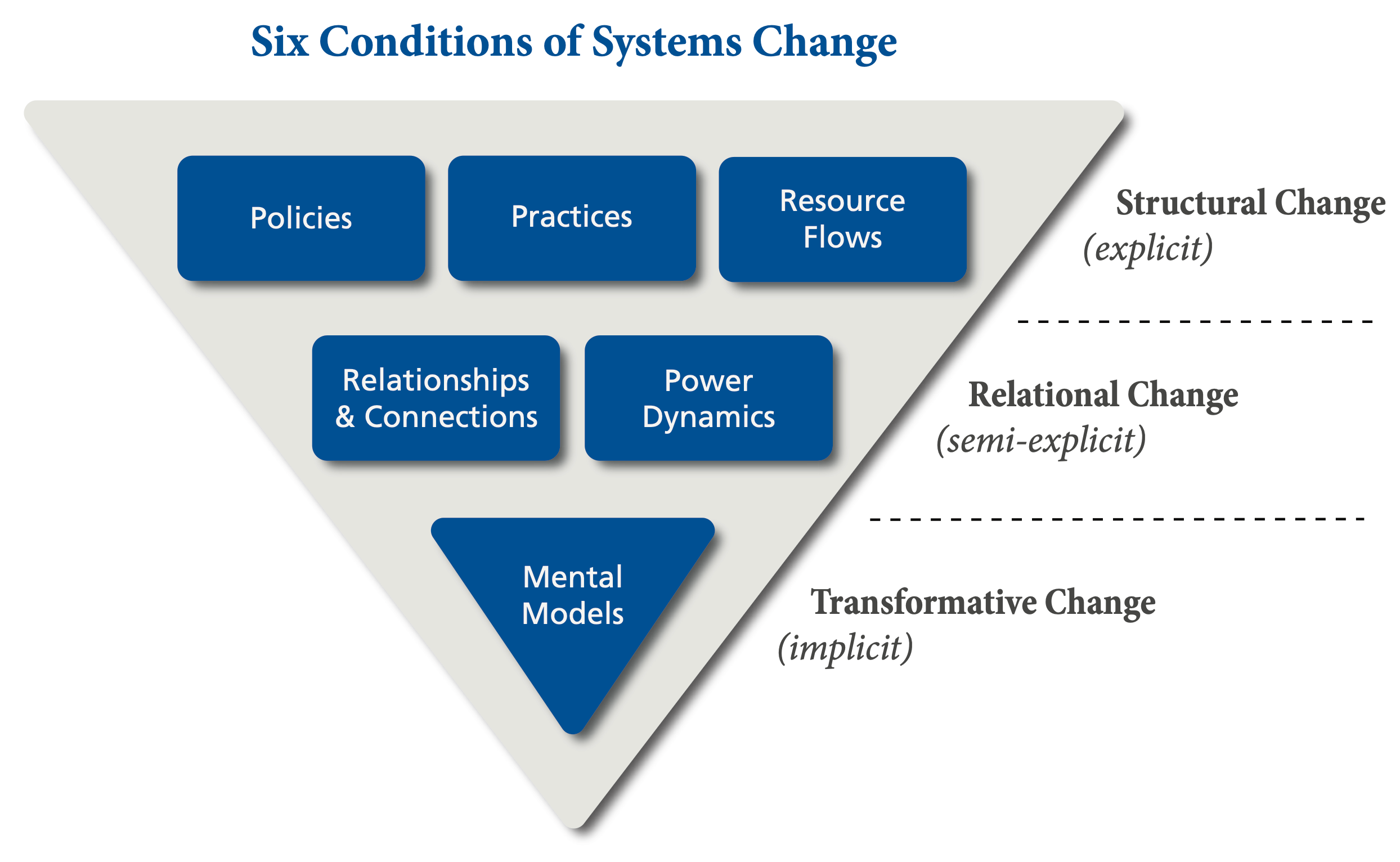A Movement to End Sexual Harm in the Music Community
Rachel Harrison, SoundCheck Aotearoa
As a sexual harm prevention consultant, I get to work with incredible humans in a wide range of industries and workplaces who care deeply about making spaces safer from sexual harm. Each group is working to address their own specific risk and protective factors1 so that their people can contribute their full selves to their mahi, whatever that is.
I have never seen one industry do so much to move toward the goal of a community free from sexual harm. And it doesn’t look like the movement is stopping. I reckon if anyone can stop sexual harassment, the Aotearoa music community can.
Music communities in Aotearoa are no different in some respects, and are also totally unique. Used to not relying on any HR departments, large employing body, or policies, music people are better at “number 8 wire-ing” it than your best farmer, and are the very definition of “getting stuck in” to make things happen. And it shows in the movement to end sexual harm that is building in the music community.
Starting with the Amplify Aotearoa report in 2019, the subsequent formation of SoundCheck Aotearoa, and supercharged with the personal stories that were told publicly and platforms such as Beneath the Glass Ceiling, the foundation for a social movement was born. And is still growing.
Since starting in 2020 as a grassroots action group, charitable trust organisation SoundCheck Aotearoa has worked with the community to run hui to gather wisdom from various music communities, published a prevention plan, implemented ongoing industry sexual harm prevention training, rolled out wānanga created by Māori for Māori in the music community, developed free resources to support safer practice, and implemented a Sexual Harm Prevention and Response Advisor Service (SHAPRA) for the music community. All in less than 4 years.

Pictured: Timeline representing a history of SoundCheck Aotearoa from 2020-2024.
While this in itself is an astonishing amount of work for a small voluntary board, a project manager, and two part time sexual harm specialists, it is the community who really takes my breath away.
In SoundCheck Aotearoa workshops, we hear about people who are doing what they can to make spaces and relationships safer: people willing to do one small thing (and sometimes many small things) to make it harder for sexual harm to happen and to respond better to harm that has happened. Each “one small thing” builds on other small things and eventually join together to create the fabric of prevention.
This kind of prevention strengthens our communities so that sexual harm is less likely to happen. These examples of prevention happen in the small conversations we have about how we will behave with each other, in the even smaller glimmers of consent culture where we offer true choice without repercussions, and in the systems change that involves policies, codes of conduct, or the implementation of the Merlin’s Pass sexual harassment system at events. Strengthening is slow and steady work that takes us all to make a difference.
There is a trick with this though. The world is not stopping. We are not dealing with a world where sexual harm hasn’t happened (yet). So as we work on prevention, more harm will be happening, and communities will need to deal with the ripple out of harm in the music community. If we are doing it right as a community, we will be making more space to hear from survivors about the harm they experienced and what might help in restoration and healing for them and their communities.
When new stories of harm emerge, it is normal for all of the harm already experienced by a community to flood back again, and it can feel like somebody should have done more to stop the problem and that nothing is happening fast enough. For those who are not hearing about prevention moments happening everyday, it can feel like there is no end to this problem and nothing is changing. The intolerable pain that trauma like sexual harm involves demands action so that it should not have to happen to one more person.
In these moments, our focus as a community is (rightly) on the people harmed and the destruction left in the wake of sexual harm. There can be intense focus on the impact on survivors, and on the betrayal of trust and loss of a collective sense of safety for everyone.
This is why any approach to addressing sexual harm needs to involve strengthening (prevention), response (to help people deal with harm and the ripple out as it happens) and healing (for people harmed, communities, and those who do harm). These three pillars (“strengthening,” “response,” and “healing”) are what the Te Tokotoru model of prevention calls the “unbreakable three.” “Unbreakable” because these three elements are all needed when addressing a complex social problem like sexual harm, and this work is long-term work. SoundCheck Aotearoa’s work with the music community is a good example of the types of activities needed across these pillars.
“Strengthening” work involves working on spaces, environments, and connections that enhance protective factors and minimise risk factors for sexual harm. For example:
Training to help people understand what sexual harm is, how to respond well, health and safety responsibilities, and bystander intervention
Resources and templates so people can integrate safer practices into their workplaces
Tailored prevention advice through the SHAPRA service
Posters, articles, and workplace conversations so people know that sexual harm is not tolerated anymore
“Responding” work involves providing support and resources at times of risk to help prevent crises. For example:
Training so people are able to respond to harm through bystander intervention training, responding to disclosures training and resources
SHAPRA service support for anyone affected by, responding to, or has done or been accused of sexual harm
Policies and procedures to help guide good practice
“Healing” work involves actions that allow healing and rebalancing as individuals and as a community. For example:
Support through the SHAPRA service for people affected by sexual harm including survivors, support people, workplaces, as well as people who have done harm or been accused
Processes and policies for people to follow once harm has happened that improves safety for everyone
Restorative and complaints processes for individuals and workplaces who have been impacted by sexual harm
Tools to help people and ventures know how to deal with the ripple out of harm, including the possible reintegration of people who have done harm
Sexual harm is a “wicked” problem—this means there is no simple recipe to end it. It is a complex, multi-faceted problem that defies simple solutions. It is also a marathon, not a sprint, and there are no shortcuts. Collective action is crucial to change the systems2 that hold this problem in place in any community. And this change needs to be tailored for each group of people and embedded into all the systems that exist in a community—essentially creating a new “normal” for everyone.

Pictured: Summary of a Systems Change Approach (Kania, Kramer and Senge, 2018.)
While the elements of a systems approach may seem like a massive challenge to undo and redo, perhaps this is the time to remember that they were constructed by humans, and we are human: we can undo systems and replace them with healthier systems.
Treating sexual harm as a community problem (rather than a problem between two people) gives a powerful message that can help prevent further offending—that this is not just a personal issue, but a collective issue that the entire community has a stake in ending. We also offer an opportunity for healing for survivors as old patterns of victim-blaming and withdrawal can be replaced by collective care and connection. This slow and steady work takes lots of us working together to make a difference.
To sustain collective action, we must look after ourselves and each other, embodying compassion wherever possible, and keeping the goal in sight—a music community free from sexual harm, so that everyone is able to contribute their full selves in whatever spaces they are in in Aotearoa and around the world.
Kia kaha music community. Let’s do this.
Notes
1
The goal of prevention is to prevent sexual violence before it happens by changing the conditions that enable harm (Carmody et al., 2009; Chamberlain, 2008). This involves identifying and decreasing risk factors associated with sexual violence and increasing protective factors that promote healthy relationships, well-being, and social norms based on respect (Chamberlain, 2008).
2
For more information about systems change, see page 17 of https://nzfvc.org.nz/sites/nzfvc.org.nz/files/NZFVC-issues-paper-13-systems-thinking.pdf
Rachel Harrison is an independent Sexual Harm Prevention Specialist, who has worked with a number of public and private sector organizations. For SoundCheck Aotearoa, Rachel developed Professional Respect Training, and co-authored the independent report ‘Creating Culture Change Around Sexual Harm in the Music Community in Aotearoa’ with Debbie Teale (2021).
SoundCheck Aotearoa is a charitable trust organisation with a mission to foster a safe and inclusive culture for the Aotearoa New Zealand music community. SoundCheck Aotearoa believes that action is needed to address inequitable representation, challenge systemic discrimination, and advance impactful change.
